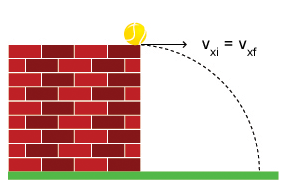Projectile Motion-Horizontal Projection
We will use our knowledge of vectors when discussing two-dimensional motion. An object after it is thrown into the air has its entire motion affected only by gravity. This is called projectile motion. The two important types of projectile motion that are discussed in this section are:
- Horizontal Projection
- Projection at an angle with respect to the horizontal
Horizontal Projection:

- When an object is launched in a horizontal direction, its initial velocity only has a horizontal component (vx) .
- Since there is no horizontal force acting on a projectile (if we ignore air resistance), its horizontal velocity will not change during its motion.
- Since the Earth’s gravitational force acts vertically downward, it causes an acceleration of 9.8m/s2 in the downward direction.
- The vertical component of the projectile’s velocity increases at the rate of 9.8m/s2.
- The kinematics equations we use for this type of projectile motion simplify to:

v y = final velocity in the vertical direction.
h = vertical displacement in the downward direction.
- You can find the horizontal distance(x), the range, of the projectile by using, x = vx* t
v x = initial velocity in the horizontal direction